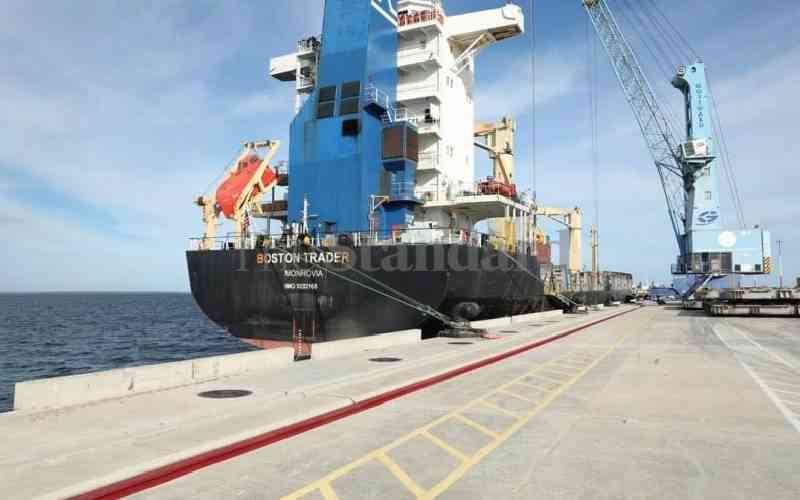By Joe Kiarie
The planned construction of another port on the Kenyan coastline is a potential threat to cultural treasures in Lamu.
Historians, tourism experts and local communities are warning the mega project at Manda Bay would condemn Lamu town, a Unesco World Heritage Site, to extinction.
Located on one of the islands that form the Lamu archipelago, the 14th-century Arab stone town is East Africa’s oldest and best-preserved Swahili settlement.
It has been continuously inhabited for more than 700 years and is famed for its unsullied culture and rich traditions.
Residents fear the town could vanish, coming hot on the heels of a global report listing Lamu among12 historic sites that are on the verge of ruin. |
The Lamu archipelago has grown as a World Heritage Site and a key tourist destination. |
The Global Heritage Fund report, Saving Our Vanishing Heritage, attributes the situation to development pressures and poor management of the town.
Albeit concurring that regional economic development far much outweighs sustaining culture, Lamu residents seem reluctant to resign to the fate of losing their priceless cultural treasures.
Better infrastructure
Save Lamu chairman Abubakar el-Amudy says the residents welcomed the project since it would boost the region in terms of infrastructure and employment.
But he says it is almost certain Lamu’s rich culture and traditions will be diluted due to the would-be influx of people from diverse backgrounds.
"It will be very painful to see our old town, dressing style, housing designs, eating habits, language and overall heritage vanish, but it seems inevitable," el-Amudy says.
He fears that on top of the imminent environmental degradation and adverse affects on the delicate marine life, coral reefs and mangroves, drug trafficking could also emerge.
"The port is likely to spur drug trafficking and abuse among youths as happens in Mombasa.
Stay informed. Subscribe to our newsletter
Lamu will be defaced in all aspects of life since the port project will have massive cultural, political and economic implications," the chairman added.
Ahmed Yassin, a resident, fears that poverty could prompt some Lamu dwellers to sell their traditional houses within the old town. This, he says, will be a sure way to the extinction of Lamu’s culture.
Dr Ephraim Wahome, a tourism lecturer at the University of Nairobi, differs, saying Lamu’s cultural outlook will not change overnight. But he concedes the town’s long-term existence is at risk.
"Lamu will not disappear just because a port has been put up. Kenya is a signatory to the International Covenant on Economic, Social and Cultural Rights, which stipulates that cultural sites be protected. These sites are also protected by Unesco and local laws," he added.
Wahome says feasibility studies for the project must have factored in the adverse effects, and that it is not a coincidence the port will be on Manda Bay, a few kilometres from Lamu Island.
But he admits the port will be a catalyst to phenomenal population growth likely to disfigure Lamu.
"For instance, as much as there is no likelihood of new buildings coming up instantly, we are likely to see slums coming up and insecurity rising," he says.
The lecturer says some adverse changes, particularly environment degradation, are already evident. "Lamu is now heavily polluted and sewage is directed into the Indian Ocean," he says.
The proposed mega project will include the port, an airport, a highway, a railway line, an oil refinery and a resort city that will cover 1,000 acres.
Mr Arthur Mahasi, a conservationist and tourism consultant, says Lamu is likely to lose its status as a Unesco World Heritage Site once the port is up and running.
Heritage site
"The unique old buildings, their designs and urban structure are among the rich cultural attractions that qualified Lamu to this status. If they are replaced with modern buildings, Lamu will no longer qualify as a Unesco site," he says.
Mahasi says Lamu, being a predominantly Islamic area, residents will suffer a culture shock once outsiders flock the region and introduce diverse foreign cultures against indigenous ones.
Residents, he says, should be psychologically prepared for this transformation.
According to Jeff Morgan, the Executive Director of the Global Heritage Fund, treasured but endangered archaeological and heritage sites in the developing world should be saved before they are lost forever.
"In the first decade of the 21st century, we have lost or seriously impaired hundreds of precious historic sites; the physical record of our human civilisation. Many have survived thousands of years, only to be lost in this generation under our watch," he says.
Lamu old town has been losing its historic outlook as wealthy European communities violate the law to build new homes and renovate traditional Swahili houses.
This frenzy has been fuelled by middle-class residents, who sell their ancestral homes in the old town to construct houses in suburbs such as Kandahar Kashmiri, Gardeni and Bombay.
The old town is a gazetted conservation area of Lamu and construction is regulated by building codes to preserve Swahili architecture.
Built in coral stone and mangrove timber, Lamu old town is exemplified by the simplicity of its structural forms enriched by features such as inner courtyards, verandas, and carved wooden doors.
Lamu has hosted major Muslim religious festivals since the 19th century, and has become a significant centre for the study of Islamic and Swahili cultures.
 The Standard Group Plc is a
multi-media organization with investments in media platforms spanning newspaper
print operations, television, radio broadcasting, digital and online services. The
Standard Group is recognized as a leading multi-media house in Kenya with a key
influence in matters of national and international interest.
The Standard Group Plc is a
multi-media organization with investments in media platforms spanning newspaper
print operations, television, radio broadcasting, digital and online services. The
Standard Group is recognized as a leading multi-media house in Kenya with a key
influence in matters of national and international interest.
 The Standard Group Plc is a
multi-media organization with investments in media platforms spanning newspaper
print operations, television, radio broadcasting, digital and online services. The
Standard Group is recognized as a leading multi-media house in Kenya with a key
influence in matters of national and international interest.
The Standard Group Plc is a
multi-media organization with investments in media platforms spanning newspaper
print operations, television, radio broadcasting, digital and online services. The
Standard Group is recognized as a leading multi-media house in Kenya with a key
influence in matters of national and international interest.









